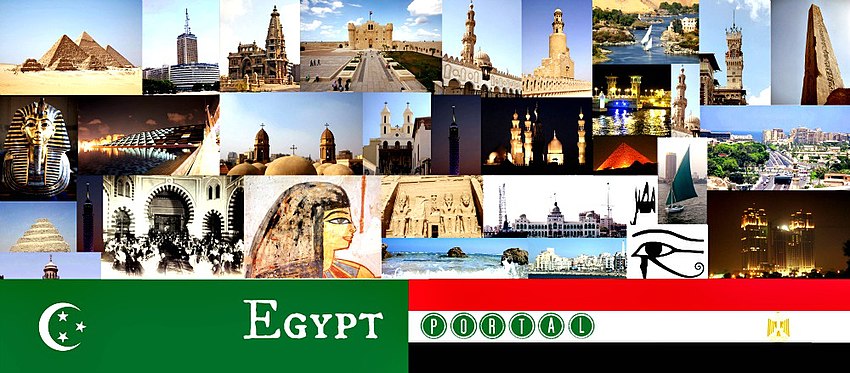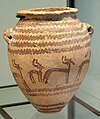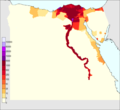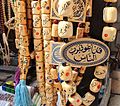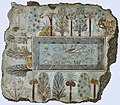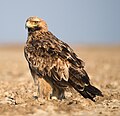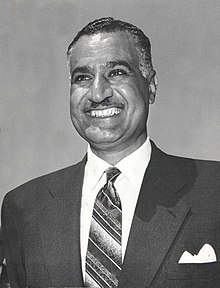Egypt (
Arabic : مصر Miṣr
[mesˁr] , Egyptian Arabic pronunciation:
[mɑsˤr] ), officially the Arab Republic of Egypt , is a
transcontinental country spanning the
northeast corner of Africa and the
Sinai Peninsula in the
southwest corner of Asia . It is bordered by the
Mediterranean Sea to
the north , the
Gaza Strip of
Palestine and
Israel to
the northeast , the
Red Sea to the east,
Sudan to
the south , and
Libya to
the west . The
Gulf of Aqaba in the northeast separates Egypt from
Jordan and
Saudi Arabia .
Cairo is the capital and
largest city of Egypt , while
Alexandria , the second-largest city, is an important industrial and tourist hub at the
Mediterranean coast . At approximately 100 million inhabitants, Egypt is the
14th-most populated country in the world , and the
third-most populated in Africa.
Egypt has one of the longest histories of any country, tracing its heritage along the
Nile Delta back to the 6th–4th millennia BCE. Considered a
cradle of civilisation ,
Ancient Egypt saw some of the earliest developments of writing, agriculture, urbanisation, organised religion and central government. Egypt was an early and important
centre of Christianity , but largely
adopted Islam in the seventh century. Cairo became the capital of the
Fatimid Caliphate in the tenth century, and of the
Mamluk Sultanate in the 13th century. Egypt then became part of the
Ottoman Empire in 1517, before its local ruler
Muhammad Ali established it as an autonomous
Khedivate in 1867. The country was then
occupied by the
British Empire and gained independence in 1922 as
a monarchy . Following the
1952 revolution , Egypt declared itself a
republic , and in 1958 it merged with
Syria to form the
United Arab Republic , which was dissolved in 1961. Egypt fought
several armed conflicts with
Israel in
1948 ,
1956 ,
1967 and
1973 , and
occupyed the
Gaza Strip intermittently until 1967. In 1978, Egypt signed the
Camp David Accords , which
recognised Israel in exchange for its withdrawal from the Sinai. After the
Arab Spring , which led to the
2011 Egyptian revolution and overthrow of
Hosni Mubarak , the country faced a
protracted period of political unrest ; this included the
election in 2012 of a brief, short-lived
Muslim Brotherhood -aligned Islamist government spearheaded by
Mohamed Morsi , and its subsequent
overthrow after
mass protests in 2013 .
Egypt is considered to be a
regional power in
North Africa , the
Middle East and the
Muslim world , and a
middle power worldwide. It is a
developing country having a diversified economy, which is the
largest in Africa , the
38th-largest economy by nominal GDP and
127th by nominal GDP per capita. Egypt is a founding member of the
United Nations , the
Non-Aligned Movement , the
Arab League , the
African Union ,
Organisation of Islamic Cooperation ,
World Youth Forum , and a member of
BRICS . (
Full article... )
The
pyramid of Sahure (
Ancient Egyptian : Ḫꜥỉ-bꜣ Sꜣḥw-Rꜥ ,
lit. 'Rising of the
ba pyramid complex built in the late 26th to 25th century BC for the
Egyptian pharaoh
Sahure of the
Fifth Dynasty . It introduced a period of pyramid building by Sahure's successors in
Abusir , on a location earlier used by
Userkaf for his
sun temple . The site was first thoroughly excavated by
Ludwig Borchardt between March 1907 and 1908, who wrote the standard work Das Grabdenkmal des Königs Sahu-Re The Funerary Monument of King Sahure ) between 1910 and 1913.
The pyramid complex's layout was adopted by succeeding kings of the Fifth and
Sixth Dynasties , marking a milestone in pyramid complex construction. Compared to the preceding
Fourth Dynasty , the immensity of the constructions was dramatically reduced but, in tandem, the
decorative programme proliferated and temples were augmented by enlarged storeroom complexes. The complex is estimated to have had 10,000 m
2 (110,000 sq ft) of finely carved
relief adorning its walls, of which 150 m
2 (1,600 sq ft) has been preserved. Some of these reliefs are considered unparalleled in
Egyptian art , such as the 8 m (26 ft) by 3 m (9.8 ft) (4.2 × 1.6
royal cubits ) hunting scene from the
mortuary temple . For comparison, Sahure's temple contained 370 running metres (1,214 running feet) of such relief decoration, while the temple of Khufu's
Great Pyramid contained 100 running metres (328 running feet). The complex is also remarkable for the array of valuable materials – such as
granite ,
alabaster and
basalt – used extensively in its construction. (
Full article... )
List of selected articles
The following are images from various Egypt-related articles on Wikipedia.
Image 1 The
Edwin Smith surgical papyrus describes anatomy and medical treatments, written in
hieratic ,
c. 1550 BC (from
Ancient Egypt )
Image 2 Change in per capita GDP of Egypt, 1820–2018. Figures are inflation-adjusted to 2011 International dollars. (from
Egypt )
Image 3 The well preserved Temple of Isis from
Philae is an example of
Egyptian architecture and
architectural sculpture (from
Ancient Egypt )
Image 5 Four colossal statues of
Ramesses II flank the entrance of his temple
Abu Simbel (from
Ancient Egypt )
Image 6 Sennedjem plows his fields in
Aaru with a pair of oxen,
Deir el-Medina (from
Ancient Egypt )
Image 7 A crowd at Cairo Stadium watching the
Egypt national football team (from
Egypt )
Image 8 Glassmaking was a highly developed art. (from
Ancient Egypt )
Image 9 A typical
Naqada II jar decorated with gazelles (Predynastic Period) (from
Ancient Egypt )
Image 10 Hatshepsut's trading expedition to the
Land of Punt (from
Ancient Egypt )
Image 11 Tutankhamun charging enemies on his
chariot , 18th dynasty. (from
Ancient Egypt )
Image 12 Pharaohs' tombs were provided with vast quantities of wealth, such as the
golden mask from the mummy of Tutankhamun . (from
Ancient Egypt )
Image 13 Egyptian tanks advancing in the Sinai desert during the
Yom Kippur War , 1973 (from
Egypt )
Image 14 The
Suez Canal (from
Egypt )
Image 15 President el-Sisi with US President
Joe Biden , 11 November 2022 (from
Egypt )
Image 17 Hieroglyphs on stela in
Louvre , c. 1321 BC (from
Ancient Egypt )
Image 18 Green irrigated land along the Nile amidst the desert and in the delta (from
Egypt )
Image 20 Egypt's population density (people per km
2 ) (from
Egypt )
Image 21 The
Al-Hakim Mosque in Cairo, of
Al-Hakim bi-Amr Allah , the sixth caliph, as renovated by
Dawoodi Bohra (from
Egypt )
Image 22 The
Giza Necropolis is the oldest of the
ancient Wonders and the only one still in existence. (from
Egypt )
Image 24 Statues of two pharaohs of Egypt's
Twenty-Fifth Dynasty and several other
Kushite kings,
Kerma Museum . (from
Ancient Egypt )
Image 25 The halls of Karnak Temple are built with rows of large columns. (from
Ancient Egypt )
Image 27 The "weighing of the heart" scene from the
Book of the Dead (from
Egypt )
Image 28 Naguib Mahfouz , the first Arabic-language writer to win the
Nobel Prize in Literature (from
Egypt )
Image 29 Egypt's topography (from
Egypt )
Image 30 A figure wearing the red crown of Lower Egypt, most probably
Amenemhat II or
Senwosret II . It functioned as a divine guardian for the
imiut ; the divine kilt, suggests that the statuette was not merely a representation of the living ruler. (from
Ancient Egypt )
Image 33 The
pyramids of Giza are among the most recognizable symbols of ancient Egyptian civilization. (from
Ancient Egypt )
Image 34 The gods
Osiris ,
Anubis , and
Horus in the tomb of Horemheb (
KV57 ) in the Valley of the Kings. (from
Ancient Egypt )
Image 35 Egypt under Muhammad Ali dynasty (from
Egypt )
Image 36 Egyptian literacy rate among the population aged 15 years and older by UNESCO Institute of Statistics (from
Egypt )
Image 37 The pharaoh was usually depicted wearing symbols of royalty and power. (from
Ancient Egypt )
Image 38 A tomb relief depicts workers plowing the fields, harvesting the crops, and threshing the grain under the direction of an overseer, painting in the tomb of
Nakht (from
Ancient Egypt )
Image 39 The
Amr ibn al-As mosque in Cairo, recognised as the oldest in Africa (from
Egypt )
Image 41 Khafre enthroned (from
Ancient Egypt )
Image 42 Prominent Egyptian dissident
Alaa Abd El-Fattah was sentenced to five years of imprisonment in December 2021. (from
Egypt )
Image 43 Protesters from the Third Square movement, which supported neither the former Morsi government nor the Armed Forces, 31 July 2013 (from
Egypt )
Image 45 The
Narmer Palette depicts the unification of the Two Lands. (from
Ancient Egypt )
Image 47 Menna and Family Hunting in the Marshes, Tomb of Menna,
c. 1400 BC (from
Ancient Egypt )
Image 49 Muhammad Ali was the founder of the
Muhammad Ali dynasty and the first
Khedive of Egypt and
Sudan . (from
Egypt )
Image 50 Measuring and recording the harvest, from the tomb of
Menna at
Thebes (Eighteenth Dynasty). (from
Ancient Egypt )
Image 51 Early tomb painting from
Nekhen ,
c. 3500 BC , Naqada, possibly Gerzeh, culture (from
Ancient Egypt )
Image 52 Women in Cairo wear face masks during the
COVID-19 pandemic in Egypt in March 2020. (from
Egypt )
Image 53 Wooden figures of soldiers, from the tomb of nomarch
Mesehti (
11th dynasty ) (from
Ancient Egypt )
Image 54 Egypt is the eighth most water stressed country in the world. (from
Egypt )
Image 55 The Ptolemaic Queen
Cleopatra VII and her son by Julius Caesar,
Caesarion , at the
Temple of Dendera (from
Egypt )
Image 56 Napoleon defeated the
Mamluk troops in the
Battle of the Pyramids , 21 July 1798, painted by
Lejeune . (from
Egypt )
Image 57 Smoke rises from oil tanks beside the
Suez Canal hit during the initial
Anglo-French assault on Egypt, 5 November 1956. (from
Egypt )
Image 58 The High Court of Justice in
Downtown Cairo (from
Egypt )
Image 59 The
Temple of Dendur , completed by 10 BC,
Metropolitan Museum of Art (New York City) (from
Ancient Egypt )
Image 60 Smart Village , a business district established in 2001 to facilitate the growth of high-tech businesses (from
Egypt )
Image 61 Egyptian honour guard soldiers during a visit of U.S. Navy Adm. Mike Mullen (from
Egypt )
Image 62 Cairo grew into a
metropolitan area with a population of over 20 million. (from
Egypt )
Image 63 Tutankhamun's burial mask is one of the major attractions of the
Egyptian Museum of Cairo. (from
Egypt )
Image 64 Hosni Mubarak was the president of Egypt from 1981 until his overthrew in 2011 (from
Egypt )
Image 65 Model of a household porch and garden,
c. 1981–1975 BC (from
Ancient Egypt )
Image 66 The
Qattara Depression in Egypt's north west (from
Egypt )
Image 67 Tourists riding an
Arabian camel in front of
Pyramid of Khafre . The
Giza Necropolis is one of Egypt's main tourist attractions. (from
Egypt )
Image 68 An offshore platform in the Darfeel Gas Field (from
Egypt )
Image 69 Seagoing ship of an expedition to Punt, from a relief of
Hatshepsut's Mortuary temple , Deir el-Bahari (from
Ancient Egypt )
Image 70 Kushari , one of Egypt's national dishes (from
Egypt )
Image 71 Soad Hosny , film star (from
Egypt )
Image 72 British infantry near
El Alamein , 17 July 1942 (from
Egypt )
Image 74 Illustration of various types of capitals, by
Karl Richard Lepsius (from
Ancient Egypt )
Image 75 Ancient Egyptians playing music (from
Egypt )
Image 76 The Weighing of the Heart from the
Book of the Dead of Ani (from
Egypt )
Image 77 Egyptians celebrated feasts and festivals, accompanied by music and dance. (from
Ancient Egypt )
Image 78 Arabic calligraphy has seen its golden age in
Cairo . This adornment and beads being sold in
Muizz Street (from
Culture of Egypt )
Image 79 Rectangular fishpond with ducks and
lotus planted round with date palms and fruit trees,
Tomb of Nebamun , Thebes, 18th Dynasty (from
Ancient Egypt )
Image 80 Tanoura dancers performing in Wekalet El Ghoury, Cairo (from
Egypt )
Image 82 Painted limestone relief of a noble member of Ancient Egyptian society during the New Kingdom (from
Ancient Egypt )
Image 83 Coffin of Khnumnakht in 12th dynasty style, with palace facade, columns of inscriptions, and two Wedjat eyes (from
Ancient Egypt )
Image 84 The
Egyptian Museum of Cairo (from
Egypt )
Image 85 Frontispiece of
Description de l'Égypte , published in 38 volumes between 1809 and 1829. (from
Ancient Egypt )
Image 86 The
Eastern Imperial Eagle is the national animal of Egypt. (from
Egypt )
Image 87 The Cairo Metro (line 2) (from
Egypt )
Image 89 Hunting game birds and plowing a field, tomb of
Nefermaat and his wife
Itet (
c. 2700 BC ) (from
Ancient Egypt )
Image 90 The preserved Temple of Horus at Edfu is a model of Egyptian architecture. (from
Ancient Egypt )
Image 91 Female nationalists demonstrating in
Cairo , 1919 (from
Egypt )
Image 93 Egyptian President
Gamal Abdel Nasser in Mansoura, 1960 (from
Egypt )
Image 94 Salah Zulfikar , film star (from
Egypt )
Image 95 Al-Azhar Park is listed as one of the world's sixty great public spaces by the
Project for Public Spaces . (from
Egypt )
Image 96 The
Book of the Dead was a guide to the deceased's journey in the afterlife. (from
Ancient Egypt )
Image 97 The
Fayum mummy portraits epitomize the meeting of Egyptian and Roman cultures. (from
Ancient Egypt )
Image 98 Lower-class occupations (from
Ancient Egypt )
Image 99 Temple of Derr ruins in 1960 (from
Egypt )
Image 100 Ruins of Deir el-Medina (from
Ancient Egypt )
Image 101 Egyptian
tomb models as funerary goods. (from
Ancient Egypt )
Image 103 Anubis , the god associated with mummification and burial rituals, attending to a mummy. (from
Ancient Egypt )
... that the
Qurna Queen 's tomb may be the only complete royal burial exported in its entirety from Egypt?
... that the
four sons of Horus were believed to have protected deceased people in
the afterlife by creating a specialized connection with the deceased's internal organs?
... that
Mount Okmok in Alaska may have contributed to the downfall of Ptolemaic Egypt?
... that the
Germanic seeress
Waluburg is only known from a
pot shard found on the island
Elephantine in southern Egypt?
... that
zanana
... that
Sobekneferu of Egypt's Twelfth Dynasty is the earliest undisputed female king to reign over ancient Egypt?
... that
Rabab Al-Kadhimi was threatened with deportation from Egypt due to the political nature of her poetry?
... that the German guitarist
Roman Bunka studied the Arabic
oud in Egypt and played in
Mohamed Mounir 's band at the
Pyramids of Giza to celebrate entering the year 2000?
Gamal Abdel Nasser Hussein (15 January 1918 – 28 September 1970) was an Egyptian military officer and politician who served as the second
president of Egypt from 1954 until his death in 1970. Nasser led the
Egyptian revolution of 1952 and introduced
far-reaching land reforms the following year. Following a 1954 attempt on his life by a
Muslim Brotherhood member, he cracked down on the organization, put President
Mohamed Naguib under
house arrest and assumed executive office. He was
formally elected president in June 1956.
Nasser's popularity in Egypt and the
Arab world skyrocketed after his
nationalization of the
Suez Canal Company and his political victory in the subsequent
Suez Crisis , known in Egypt as the
Tripartite Aggression . Calls for
pan-Arab unity under his leadership increased, culminating with the formation of the
United Arab Republic with
Syria from 1958 to 1961. In 1962, Nasser began a series of major
socialist measures and modernization reforms in Egypt. Despite setbacks to his
pan-Arabist cause, by 1963 Nasser's supporters gained power in several Arab countries, but he became embroiled in the
North Yemen Civil War , and eventually the much larger
Arab Cold War . He began his second presidential term
in March 1965 after his political opponents were banned from running. Following Egypt's defeat by Israel in the
Six-Day War of 1967, Nasser resigned, but he returned to office after popular demonstrations called for his reinstatement. By 1968, Nasser had appointed himself prime minister, launched the
War of Attrition to regain the
Israeli-occupied Sinai Peninsula , began a process of depoliticizing the military, and issued a set of political liberalization reforms. After the conclusion of the
1970 Arab League summit , Nasser suffered a heart attack and died. His funeral in
Cairo drew five to six million mourners, and prompted an outpouring of grief across the Arab world. (
Full article... )
List of selected biographies
Molokhiya , a traditional dish that dates back to
Ancient Egypt , served with rice and chicken.
Egyptian cuisine makes heavy use of poultry,
legumes ,
vegetables and fruit from
Egypt 's rich
Nile Valley and
Delta .
Examples of Egyptian dishes include
rice-stuffed vegetables and grape leaves ,
hummus ,
falafel ,
shawarma ,
kebab and
kofta . Others include
ful medames , mashed
fava beans ;
koshary , lentils and pasta; and
molokhiya ,
bush okra stew.
A local type of
pita bread known as
eish baladi (
Egyptian Arabic :
عيش بلدي ) is a staple of Egyptian cuisine, and cheesemaking in Egypt dates back to the
First Dynasty of Egypt , with
Domiati being the most popular type of cheese consumed today. (
Full article... )
Religions in Egypt
Arab states
Other countries
... that the
Lavon Affair was a failed Israeli
false flag operation in which bombs were planted inside Egyptian-, American-, and British-owned civilian targets such as cinemas, libraries, and American educational centers?
NC - Non-consecutive terms; Bold - Current
Beverages
Non-alcoholic beverages Alcoholic beverages
Breads Appetizers Cheeses Soups Dishes Grilled meats Desserts Common ingredients
Related cuisines
Official language Spoken Arabic dialects Historical languages Minority languages Foreign languages Immigrant minority languages Sign languages
Public institutions National institutions Private institutions
Category puzzle
Select [►] to view subcategories
This list was generated from
these rules . Questions and feedback
are always welcome ! The search is being run daily with the most recent ~14 days of results.
Note: Some articles may not be relevant to this project.
Rules |
Match log |
Results page (for watching) | Last updated: 2024-04-22 20:21 (UTC)
Note : The list display can now be customized by each user. See
List display personalization for details.
Siege of Akka (1832) (
talk |
history |
links |
watch |
logs |
tools ) by
Kolya Muratov (
talk ·
contribs ·
new pages (2) ) started on 2024-04-18, score: 27
Fatma Aly (
talk |
history |
links |
watch |
logs |
tools ) by
Kalakpagh (
talk ·
contribs ·
new pages (7) ) started on 2024-04-18, score: 36
Yemeni civil war (1994) (
talk |
history |
links |
watch |
logs |
tools ) by
Robertsky (
talk ·
contribs ·
new pages (270) ) started on 2024-04-18, score: 24
Abydos King List (Ramesses II) (
talk |
history |
links |
watch |
logs |
tools ) by
A. Parrot (
talk ·
contribs ·
new pages (1) ) started on 2024-04-18, score: 22
Enrique Meneses (
talk |
history |
links |
watch |
logs |
tools ) by
NoahRiffe (
talk ·
contribs ·
new pages (1) ) started on 2024-04-17, score: 37
The Corning Ewer (
talk |
history |
links |
watch |
logs |
tools ) by
TiaIvy (
talk ·
contribs ·
new pages (1) ) started on 2024-04-17, score: 42
Derrick Main (
talk |
history |
links |
watch |
logs |
tools ) by
Jevansen (
talk ·
contribs ·
new pages (934) ) started on 2024-04-17, score: 42
Fasel Men El Lahazat El Lazeeza (
talk |
history |
links |
watch |
logs |
tools ) by
Midwood123 (
talk ·
contribs ·
new pages (1) ) started on 2024-04-17, score: 22
Isis (journal, 1816) (
talk |
history |
links |
watch |
logs |
tools ) by
Martin Libenson (
talk ·
contribs ·
new pages (4) ) started on 2024-04-16, score: 22
History of Urfa (
talk |
history |
links |
watch |
logs |
tools ) by
Aintabli (
talk ·
contribs ·
new pages (7) ) started on 2024-04-16, score: 21
Battle of Hims (1832) (
talk |
history |
links |
watch |
logs |
tools ) by
Kolya Muratov (
talk ·
contribs ·
new pages (2) ) started on 2024-04-16, score: 29
2009 African Rhythmic Gymnastics Championships (
talk |
history |
links |
watch |
logs |
tools ) by
Maniakilljoy97 (
talk ·
contribs ·
new pages (20) ) started on 2024-04-16, score: 42


